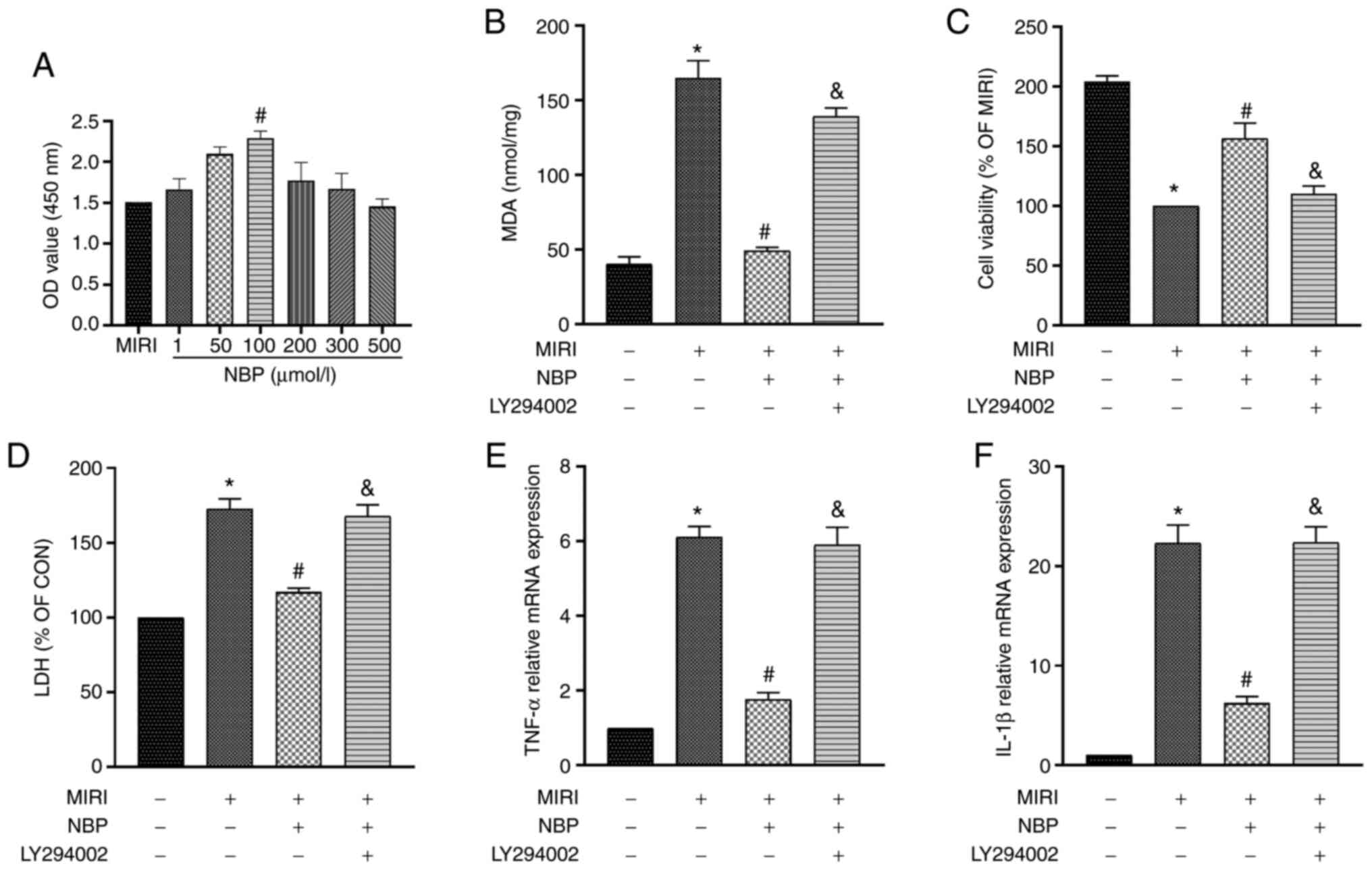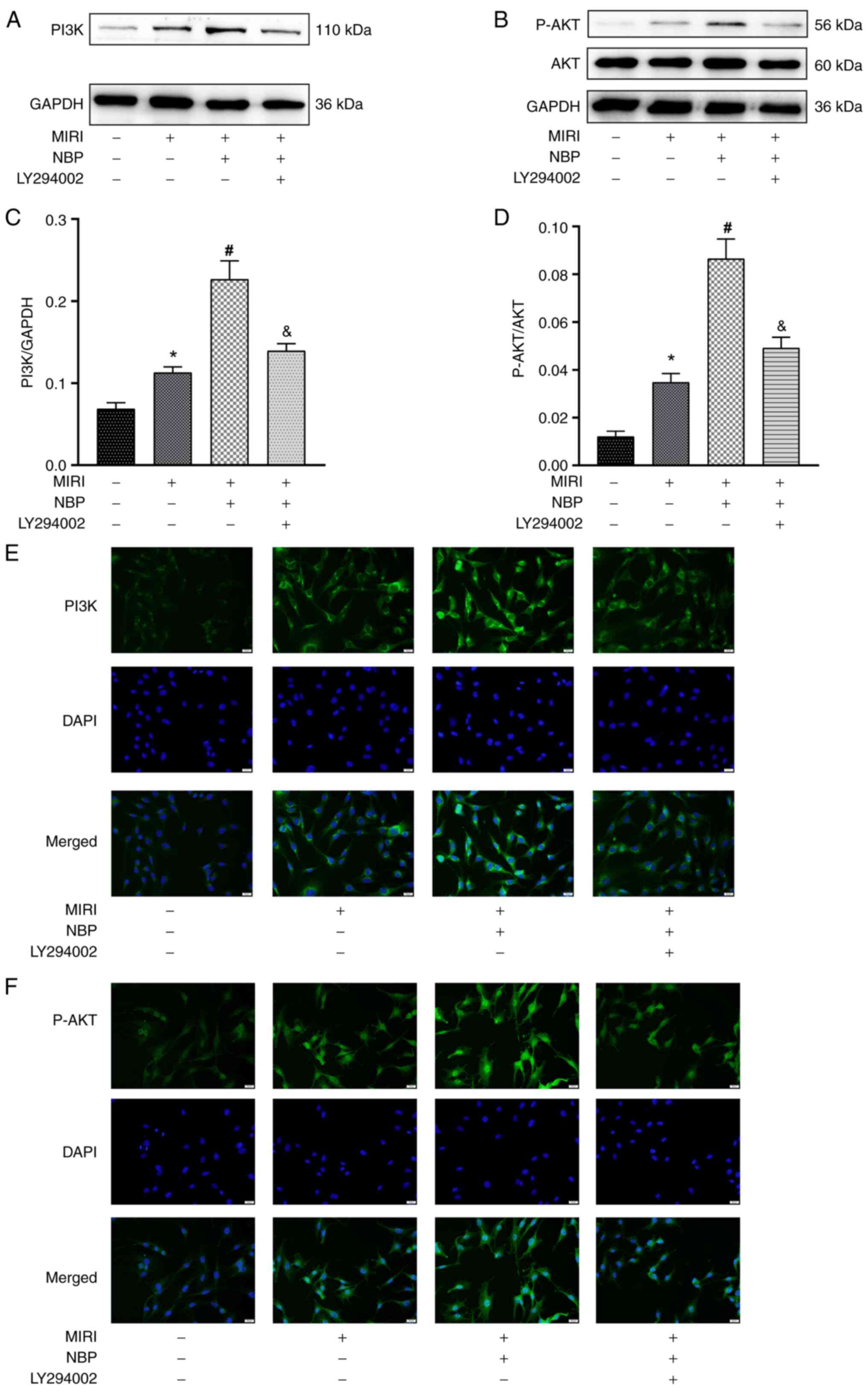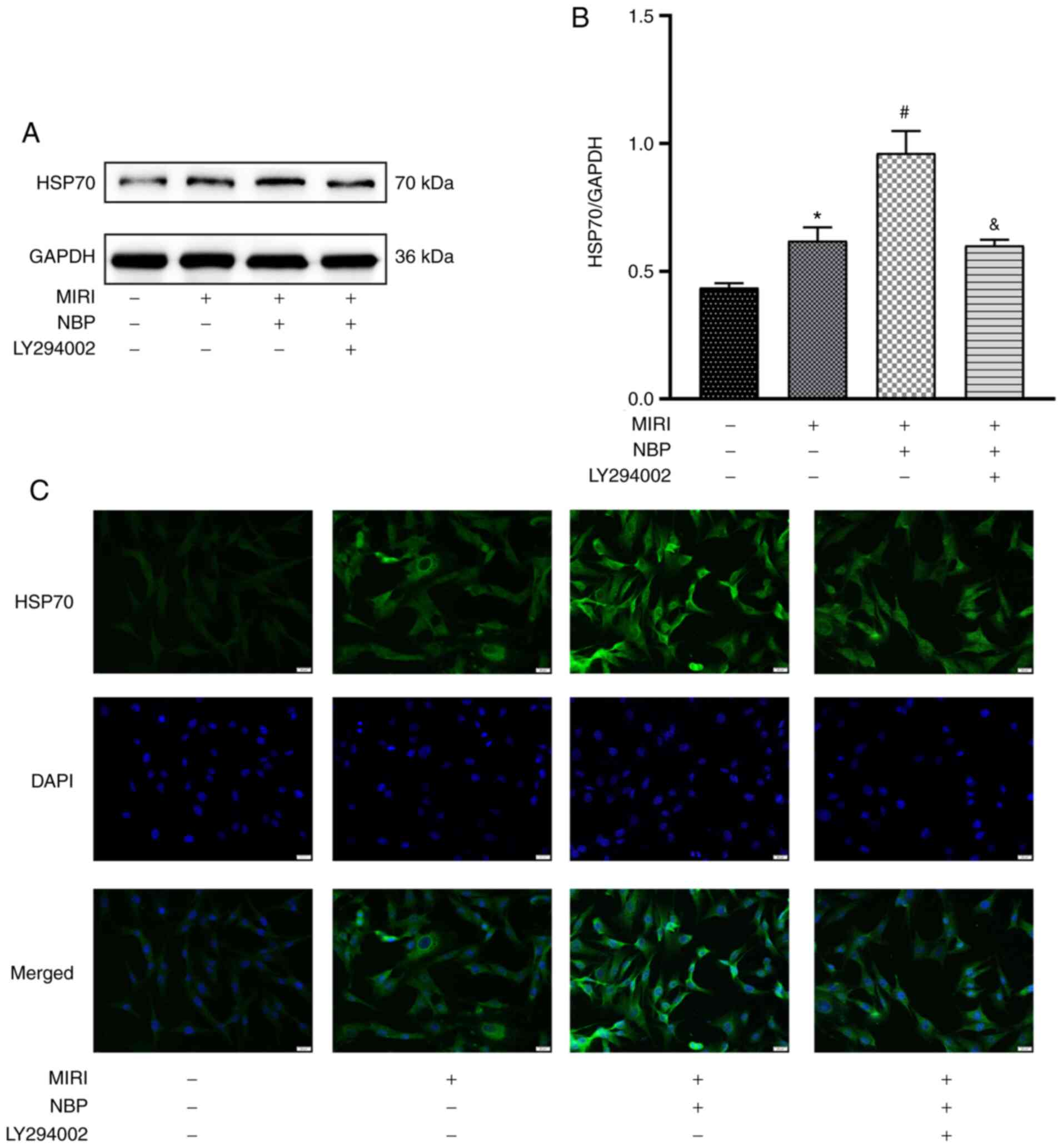|
1
|
Wang BF and Yoshioka J: The emerging role
of thioredoxin-interacting protein in myocardial
ischemia/reperfusion injury. J Cardiovasc Pharmacol Ther.
22:219–229. 2017.PubMed/NCBI View Article : Google Scholar
|
|
2
|
Li X, Liu M, Sun R, Zeng Y, Chen S and
Zhang P: Protective approaches against myocardial ischemia
reperfusion injury. Exp Ther Med. 12:3823–3829. 2016.PubMed/NCBI View Article : Google Scholar
|
|
3
|
Chin KY, Qin C, May L, Ritchie RH and
Woodman OL: New pharmacological approaches to the prevention of
myocardial ischemia-reperfusion injury. Curr Drug Targets.
18:1689–1711. 2017.PubMed/NCBI View Article : Google Scholar
|
|
4
|
Esposito ML, Zhang Y, Qiao X, Reyelt L,
Paruchuri V, Schnitzler GR, Morine KJ, Annamalai SK, Bogins C,
Natov PS, et al: Left ventricular unloading before reperfusion
promotes functional recovery after acute myocardial infarction. J
Am Coll Cardiol. 72:501–514. 2018.PubMed/NCBI View Article : Google Scholar
|
|
5
|
Wang Z, Wang Y, Ye J, Lu X, Cheng Y, Xiang
L, Chen L, Feng W, Shi H, Yu X, et al: bFGF attenuates endoplasmic
reticulum stress and mitochondrial injury on myocardial
ischaemia/reperfusion via activation of PI3K/Akt/ERK1/2 pathway. J
Cell Mol Med. 19:595–607. 2015.PubMed/NCBI View Article : Google Scholar
|
|
6
|
Radons J: The human HSP70 family of
chaperones: Where do we stand? Cell Stress Chaperones. 21:379–404.
2016.PubMed/NCBI View Article : Google Scholar
|
|
7
|
Guo S, Gao C, Xiao W, Zhang J, Qu Y, Li J
and Ye F: Matrine protects cardiomyocytes from ischemia/reperfusion
injury by regulating HSP70 expression via activation of the
JAK2/STAT3 pathway. Shock. 50:664–670. 2018.PubMed/NCBI View Article : Google Scholar
|
|
8
|
Wright MA, Aprile FA, Bellaiche MM,
Michaels TC, Muller T, Arosio P, Vendruscolo M, Dobson CM and
Knowles TP: Cooperative assembly of Hsp70 subdomain clusters.
Biochemistry. 57:3641–3649. 2018.PubMed/NCBI View Article : Google Scholar
|
|
9
|
Tang L, Mo Y, Li Y, Zhong Y, He S, Zhang
Y, Tang Y, Fu S, Wang X and Chen A: Urolithin A alleviates
myocardial ischemia/reperfusion injury via PI3K/Akt pathway.
Biochem Biophys Res Commun. 486:774–780. 2017.PubMed/NCBI View Article : Google Scholar
|
|
10
|
Zhang BF, Jiang H, Chen J, Guo X, Li Y, Hu
Q and Yang S: Nobiletin ameliorates myocardial ischemia and
reperfusion injury by attenuating endoplasmic reticulum
stress-associated apoptosis through regulation of the PI3K/AKT
signal pathway. Int Immunopharmacol. 73:98–107. 2019.PubMed/NCBI View Article : Google Scholar
|
|
11
|
Thokala S, Inapurapu S, Bodiga VL, Vemuri
PK and Bodiga S: Loss of ErbB2-PI3K/Akt signaling prevents zinc
pyrithione-induced cardioprotection during ischemia/reperfusion.
Biomed Pharmacother. 88:309–324. 2017.PubMed/NCBI View Article : Google Scholar
|
|
12
|
Vanhaesebroeck B, Guillermet-Guibert J,
Graupera M and Bilanges B: The emerging mechanisms of
isoform-specific PI3K signalling. Nat Rev Mol Cell Biol.
11:329–341. 2010.PubMed/NCBI View
Article : Google Scholar
|
|
13
|
Sulaiman D, Li J, Devarajan A, Cunningham
CM, Li M, Fishbein GA, Fogelman AM, Eghbali M and Reddy ST:
Paraoxonase 2 protects against acute myocardial
ischemia-reperfusion injury by modulating mitochondrial function
and oxidative stress via the PI3K/Akt/GSK-3β RISK pathway. J Mol
Cell Cardiol. 129:154–164. 2019.PubMed/NCBI View Article : Google Scholar
|
|
14
|
Hausenloy DJ and Yellon DM: New directions
for protecting the heart against ischaemia-reperfusion injury:
Targeting the reperfusion injury salvage kinase (RISK)-pathway.
Cardiovasc Res. 61:448–460. 2004.PubMed/NCBI View Article : Google Scholar
|
|
15
|
Damilano F, Perino A and Hirsch E: PI3K
kinase and scaffold functions in heart. Ann N Y Acad Sci.
1188:39–45. 2010.PubMed/NCBI View Article : Google Scholar
|
|
16
|
Zhai C, Lv J, Wang K, Li Q and Qu Y: HSP70
silencing aggravates apoptosis induced by hypoxia/reoxygenation
in vitro. Exp Ther Med. 18:1013–1020. 2019.PubMed/NCBI View Article : Google Scholar
|
|
17
|
Ji K, Xue L, Cheng J and Bai Y:
Preconditioning of H2S inhalation protects against cerebral
ischemia/reperfusion injury by induction of HSP70 through
PI3K/Akt/Nrf2 pathway. Brain Res Bull. 121:68–74. 2016.PubMed/NCBI View Article : Google Scholar
|
|
18
|
Abdoulaye IA and Guo YJ: A review of
recent advances in neuroprotective potential of 3-N-Butylphthalide
and its derivatives. Biomed Res Int. 2016(5012341)2016.PubMed/NCBI View Article : Google Scholar
|
|
19
|
Zhao Y, Lee JH, Chen D, Gu X, Caslin A, Li
J, Yu SP and Wei L: DL-3-n-butylphthalide induced neuroprotection,
regenerative repair, functional recovery and psychological benefits
following traumatic brain injury in mice. Neurochem Int. 111:82–92.
2017.PubMed/NCBI View Article : Google Scholar
|
|
20
|
Qin C, Zhou P, Wang L, Mamtilahun M, Li W,
Zhang Z, Yang GY and Wang Y: Dl-3-N-butylphthalide attenuates
ischemic reperfusion injury by improving the function of cerebral
artery and circulation. J Cereb Blood Flow Metab. 39:2011–2021.
2019.PubMed/NCBI View Article : Google Scholar
|
|
21
|
Kawasaki K, Yano K, Sasaki K, Tawara S,
Ikegaki I, Satoh S, Ohtsuka Y, Yoshino Y, Kuriyama H, Asano T and
Seto M: Correspondence between neurological deficit, cerebral
infarct size, and rho-kinase activity in a rat cerebral thrombosis
model. J Mol Neurosci. 39:59–68. 2009.PubMed/NCBI View Article : Google Scholar
|
|
22
|
Zhao Q, Zhang C, Wang X, Chen L, Ji H and
Zhang Y: (S)-ZJM-289, a nitric oxide-releasing derivative of
3-n-butylphthalide, protects against ischemic neuronal injury by
attenuating mitochondrial dysfunction and associated cell death.
Neurochem Int. 60:134–144. 2012.PubMed/NCBI View Article : Google Scholar
|
|
23
|
Zhang P, Guo ZF, Xu YM, Li YS and Song JG:
N-Butylphthalide (NBP) ameliorated cerebral ischemia
reperfusion-induced brain injury via HGF-regulated TLR4/NF-κB
signaling pathway. Biomed Pharmacother. 83:658–666. 2016.PubMed/NCBI View Article : Google Scholar
|
|
24
|
Liao D, Xiang D, Dang R, Xu P, Wang J, Han
W, Fu Y, Yao D, Cao L and Jiang P: Neuroprotective effects of
dl-3-n-Butylphthalide against doxorubicin-induced
neuroinflammation, oxidative stress, endoplasmic reticulum stress,
and behavioral changes. Oxid Med Cell Longev.
2018(9125601)2018.PubMed/NCBI View Article : Google Scholar
|
|
25
|
Wang YG, Li Y, Wang CY, Ai JW, Dong XY,
Huang HY, Feng ZY, Pan YM, Lin Y, Wang BX and Yao LL:
L-3-n-Butylphthalide protects rats' cardiomyocytes from
ischaemia/reperfusion-induced apoptosis by affecting the
mitochondrial apoptosis pathway. Acta Physiol (Oxf). 210:524–533.
2014.PubMed/NCBI View Article : Google Scholar
|
|
26
|
Qiu H, Wu H, Ma J, Cao H, Huang L, Qiu W,
Peng Y and Ding C: DL-3-n-Butylphthalide reduces atrial
fibrillation susceptibility by inhibiting atrial structural
remodeling in rats with heart failure. Naunyn Schmiedebergs Arch
Pharmacol. 391:323–334. 2018.PubMed/NCBI View Article : Google Scholar
|
|
27
|
Qiu H, Ma J, Wu H and Ding C:
DL-3-n-butylphthalide improves ventricular function, and prevents
ventricular remodeling and arrhythmias in post-MI rats. Naunyn
Schmiedebergs Arch Pharmacol. 391:627–637. 2018.PubMed/NCBI View Article : Google Scholar
|
|
28
|
Yu P, Ma S, Dai X and Cao F: Elabela
alleviates myocardial ischemia reperfusion-induced apoptosis,
fibrosis and mitochondrial dysfunction through PI3K/AKT signaling.
Am J Transl Res. 12:4467–4477. 2020.PubMed/NCBI
|
|
29
|
Livak KJ and Schmittgen TD: Analysis of
relative gene expression data using real-time quantitative PCR and
the 2(-Delta Delta C(T)) Method. Methods. 25:402–408.
2001.PubMed/NCBI View Article : Google Scholar
|
|
30
|
Zhao D, Yang J and Yang L: Insights for
oxidative stress and mTOR signaling in myocardial
ischemia/reperfusion injury under diabetes. Oxid Med Cell Longev.
2017(6437467)2017.PubMed/NCBI View Article : Google Scholar
|
|
31
|
Amani M, Jeddi S, Ahmadiasl N, Usefzade N
and Zaman J: Effect of HEMADO on level of CK-MB and LDH enzymes
after ischemia/reperfusion injury in isolated rat heart.
Bioimpacts. 3:101–104. 2013.PubMed/NCBI View Article : Google Scholar
|
|
32
|
Xu Z, Wang D, Zhou Z, Chen Q, Zhang D,
Chen S, Jiang H, Jia C and Liu X: Dexmedetomidine attenuates renal
and myocardial ischemia/reperfusion injury in a dose-dependent
manner by inhibiting inflammatory response. Ann Clin Lab Sci.
49:31–35. 2019.PubMed/NCBI
|
|
33
|
Zhang C, He M, Ni L, He K, Su K, Deng Y,
Li Y and Xia H: The role of arachidonic acid metabolism in
myocardial ischemia-reperfusion injury. Cell Biochem Biophys.
78:255–265. 2020.PubMed/NCBI View Article : Google Scholar
|
|
34
|
Liu H, Yang L, Wu HJ, Chen KH, Lin F, Li
G, Sun HY, Xiao GS, Wang Y and Li GR: Water-soluble acacetin
prodrug confers significant cardioprotection against
ischemia/reperfusion injury. Sci Rep. 6(36435)2016.PubMed/NCBI View Article : Google Scholar
|
|
35
|
Wang S, Ma F, Huang L, Zhang Y and Peng Y,
Xing C, Feng Y, Wang X and Peng Y: Dl-3-n-Butylphthalide (NBP): A
promising therapeutic agent for ischemic stroke. CNS Neurol Disord
Drug Targets. 17:338–347. 2018.PubMed/NCBI View Article : Google Scholar
|
|
36
|
Wang F, Ma J, Han F, Guo X, Meng L, Sun Y,
Jin C, Duan H, Li H and Peng Y: DL-3-n-butylphthalide delays the
onset and progression of diabetic cataract by inhibiting oxidative
stress in rat diabetic model. Sci Rep. 6(19396)2016.PubMed/NCBI View Article : Google Scholar
|
|
37
|
Bai M, Pan CL, Jiang GX, Zhang YM and
Zhang Z: Effects of butylphthalide on oxidative stress and
inflammatory response in rats with myocardial infarction through
Akt/Nrf2 signaling pathway. Eur Rev Med Pharmacol Sci.
23:9642–9650. 2019.PubMed/NCBI View Article : Google Scholar
|
|
38
|
Liu X, Zhang C, Zhang C, Li J, Guo W, Yan
D, Yang C, Zhao J, Xia T, Wang Y, et al: Heat shock protein 70
inhibits cardiomyocyte necroptosis through repressing autophagy in
myocardial ischemia/reperfusion injury. In Vitro Cell Dev Biol
Anim. 52:690–698. 2016.PubMed/NCBI View Article : Google Scholar
|
|
39
|
Yuan X, Juan Z, Zhang R, Sun X, Yan R, Yue
F, Huang Y, Yu J and Xia X: Clemastine fumarate protects against
myocardial ischemia reperfusion injury by activating the
TLR4/PI3K/Akt signaling pathway. Front Pharmacol.
11(28)2020.PubMed/NCBI View Article : Google Scholar
|
|
40
|
Tsikas D: Assessment of lipid peroxidation
by measuring malondialdehyde (MDA) and relatives in biological
samples: Analytical and biological challenges. Anal Biochem.
524:13–30. 2017.PubMed/NCBI View Article : Google Scholar
|
|
41
|
Ma C, Xu Z and Lv H: Low n-6/n-3 PUFA
ratio improves inflammation and myocardial ischemic reperfusion
injury. Biochem Cell Biol. 97:621–629. 2019.PubMed/NCBI View Article : Google Scholar
|
|
42
|
Xiong J, Yuan YJ, Xue FS, Wang Q, Cheng Y,
Li RP, Liao X and Liu JH: Postconditioning with α7nAChR agonist
attenuates systemic inflammatory response to myocardial
ischemia-reperfusion injury in rats. Inflammation. 35:1357–1364.
2012.PubMed/NCBI View Article : Google Scholar
|
|
43
|
Sun M, Dawood F, Wen WH, Chen M, Dixon I,
Kirshenbaum LA and Liu PP: Excessive tumor necrosis factor
activation after infarction contributes to susceptibility of
myocardial rupture and left ventricular dysfunction. Circulation.
110:3221–3228. 2004.PubMed/NCBI View Article : Google Scholar
|
|
44
|
Weber A, Wasiliew P and Kracht M:
Interleukin-1 (IL-1) pathway. Sci Signal. 3(cm1)2010.PubMed/NCBI View Article : Google Scholar
|
|
45
|
Neri M, Fineschi V, Di Paolo M, Pomara C,
Riezzo I, Turillazzi E and Cerretani D: Cardiac oxidative stress
and inflammatory cytokines response after myocardial infarction.
Curr Vasc Pharmacol. 13:26–36. 2015.PubMed/NCBI View Article : Google Scholar
|
|
46
|
Yao H and Han X and Han X: The
cardioprotection of the insulin-mediated PI3K/Akt/mTOR signaling
pathway. Am J Cardiovasc Drugs. 14:433–442. 2014.PubMed/NCBI View Article : Google Scholar
|
|
47
|
Wei D, Xu H, Gai X and Jiang Y:
Astragaloside IV alleviates myocardial ischemia-reperfusion injury
in rats through regulating PI3K/AKT/GSK-3β signaling pathways. Acta
Cir Bras. 34(e201900708)2019.PubMed/NCBI View Article : Google Scholar
|
|
48
|
Juhaszova M, Zorov DB, Yaniv Y, Nuss HB,
Wang S and Sollott SJ: Role of glycogen synthase kinase-3beta in
cardioprotection. Circ Res. 104:1240–1252. 2009.PubMed/NCBI View Article : Google Scholar
|
|
49
|
Son TW, Yun SP, Yong MS, Seo BN, Ryu JM,
Youn HY, Oh YM and Han HJ: Netrin-1 protects hypoxia-induced
mitochondrial apoptosis through HSP27 expression via DCC- and
integrin a6b4-dependent Akt, GSK-3β, and HSF-1 in mesenchymal stem
cells. Cell Death Dis. 4(e563)2013.PubMed/NCBI View Article : Google Scholar
|
|
50
|
Nair SP and Sharma RK: Heat shock proteins
and their expression in primary murine cardiac cell populations
during ischemia and reperfusion. Mol Cell Biochem. 464:21–26.
2020.PubMed/NCBI View Article : Google Scholar
|
|
51
|
Xu NW, Chen Y, Liu W, Chen YJ, Fan ZM, Liu
M and Li LJ: Inhibition of JAK2/STAT3 signaling pathway suppresses
proliferation of burkitt's lymphoma raji cells via cell cycle
progression, apoptosis, and oxidative stress by modulating HSP70.
Med Sci Monit. 24:6255–6263. 2018.PubMed/NCBI View Article : Google Scholar
|
|
52
|
Staib JL, Quindry JC, French JP, Criswell
DS and Powers SK: Increased temperature, not cardiac load,
activates heat shock transcription factor 1 and heat shock protein
72 expression in the heart. Am J Physiol Regul Integr Comp Physiol.
292:R432–R439. 2007.PubMed/NCBI View Article : Google Scholar
|

















